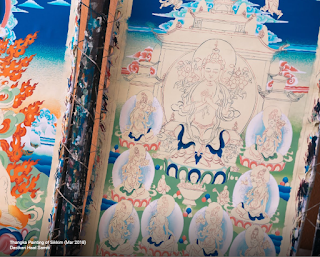#3. Sikkim Art and Handicraft Culture
So guys, I found some more amazing facts about thangka painting of sikkim ans I would really like to share them with you :
----------------------------------------------------
Thangka paintings are also worshipped as part of
religious festivals. Commissioning a thangka is considered a means of
generating spiritual merit. In times of particular hardship, an individual can
consult a lama to recommend the creation of a thangka to a particular deity. In
Sikkim - a significant centre of Buddhism in north eastern India - birth and
especially death, are occasions when a special thangka is commissioned.
Thangka
of Buddha’s first sermon.
The prince Siddhartha had been travelling with
five ascetic companions. Together they had sought the truth through extreme
deprivation.
When Gautama realized that enlightenment would
come from mental cultivation rather than depriving the body, his companions
scorned him and left him.
Upon attaining enlightenment, the Buddha sought
out his former companions to share his realization. They went on to become his
first disciples.
A thangka is a product of painstaking work and
detailing. A thangka like this one from the early 20th century would have taken
the artist a few months in order to paint details as fine as the motifs on the
fabrics worn, or individual strands of hair.
Thangkas perform various functions. Most
importantly, they are used to enhance meditative practice. They act as a visual
aid to focus concentration and forge a link between the practitioner and the
depicted deity.
Thangka
of Buddha Vajradhara and Wisdom Mandala
A mandala is a device for Tantric meditation. A
visual aid for concentration, it is also a graphic representation of the
process.
The blue Buddha and the Mandala are both
symbolic of the nature of the mind.
This thangka was painted in 1919 by Rinzing
Lharipa using gemstone powder and gold dust.
Thangka
of The Wheel of Life
An example of a thangka illustrating a Buddhist
concept, this thangka is often considered the essence of Buddhist teaching.
Holding or turning the wheel is Yama, the god
of death with his crown of skulls.
At the centre of the Mandala are the connected
images of a pig, a rooster, and a snake. Symbolizing ignorance, greed, and
aggression, these are at the centre of the worlds of suffering and
dissatisfaction.
The cycle of birth and death is split into six
segments or realms. At the top right of the thangka, the Buddha points to show
a way out of this unending cycle.
Every Buddhist home has its own family shrine,
where thangkas are an essential component. The style of painting is in the
Tibetan tradition, and the themes are similar. Additionally, there are some
thangkas that reflect the syncretic character of local Buddhist practice,
depicting deities and events that are particular to Sikkim.
Sikkim
Thangka
Depicting the creation of the kingdom of
Sikkim, the original of this thangka is said to have been commissioned by the
last Chogyal or priest-king of Sikkim.
The thangka uses Buddhist imagery common to
religious thangkas, to tell of the founding of Sikkim, which was prophesied by
Guru Padmasambhava or Guru Rimpoche, the patron saint of Sikkim.
The four central figures are the three venerated
lamas, along with the first Chogyal (second from Right). In 1642, the founder
of the Nyingmapa sect in Sikkim along with two other learned lamas, consecrated
Phuntsog Namgyal as the first Chogyal. The monarchy continued till 1975.
The thangka is replete with Tibetan and
Sikkimese symbolism. The fiery red-countenanced deity riding the mythical snow
lion and holding aloft the banner of victory is Kanchendzonga, the protector
deity of Sikkim.
Below him is Mahakala, the black deity atop the
black horse, considered in Tibetan Buddhism as the protector of monasteries.
The white figure in the centre is the deity of
the Nagas, held sacred in local belief systems of Sikkim.
The thangka captures the syncretic spirit of
Buddhism as it is practiced in Sikkim.
-----------------------------------------------------------------------------------------------------------------------------------
That's all for this blog guys. I'll be back soon with more facts and some mythical points about Sikkim art culture..
blog by- Aditi Kashyap [XC]






Good
ReplyDeleteSuperb
ReplyDeleteNice blog...keep it up
ReplyDeleteQuite informative
ReplyDeleteNice
ReplyDeleteGood
ReplyDeleteIts amazing
ReplyDeleteNice blog
ReplyDeleteNicely done👍🏻
ReplyDeleteSuch an informative blog.. I really like the content!!💯👏🏻
ReplyDeleteVery informative 👏👍 thanks for sharing
ReplyDelete